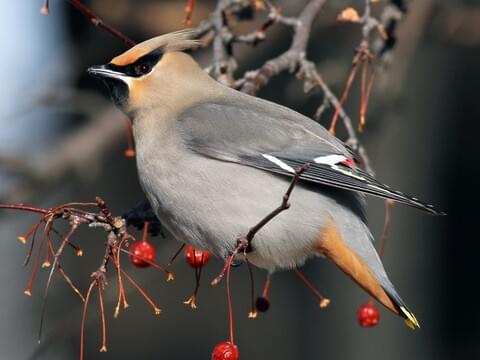Bohemian Waxwings don’t defend breeding territories and don’t often return to the same areas to breed, unlike many songbirds. This lack of territoriality is most likely the result of the ephemeral and clumped nature of the fruit they rely on. Perhaps because they don’t defend territories, they also don’t have a true song—songs that other birds use to defend territory. Bohemian Waxwings form monogamous pairs for the duration of the breeding season, but pairs frequently form during winter. Males court females by fluffing up body feathers, raising the crest, and pushing the tail downward. After grabbing a female’s attention, the male passes food to the female and she passes it back to him. They continue to pass the food back and forth up to 14 times before mating. They are very social birds and form large flocks during the winter to help find fruits scattered across the landscape. Flocks often range from 50 to 300 birds, and can sometimes be in the thousands. American Robins and Cedar Waxwings sometimes join Bohemian Waxwing flocks.


Habitat
Bohemian Waxwings breed in open evergreen and mixed forests frequently near lakes, ponds, or streams in northern North America and Eurasia. During the nonbreeding season they roam through open woodlands, urban areas, roadsides, and parks, stopping wherever they find fruit.

Food
The Bohemian Waxwing eats insects and some fruit during the breeding season, but switches to eating almost entirely fruit during the nonbreeding season. When catching insects it flies out and back, often from an exposed perch, to grab prey in midair. It picks fruit from trees and shrubs and swallows it whole. It eats almost any fruit available including strawberry, mulberry, serviceberry, raspberry, mountain ash, cranberry, hawthorn, Russian olive, and apple. During the winter waxwings eat dried fruits. The higher sugar content of dried fruit means that waxwings frequently drink water and even eat snow to help with digestion. As winter turns to spring, birds also take sap dripping from maple and birch trees.

Nesting
Bohemian Waxwings nest along forest edges and openings near lakes, streams, and marshy areas. The nest is frequently on a horizontal branch of an evergreen, aspen, or alder tree.
NEST DESCRIPTION
Male and female Bohemian Waxwings gather evergreen twigs, grasses, mosses, and other plant fibers, but only the female builds the nest. She weaves the material together to from a cup nest that is approximately 6 inches across and 3 inches deep. The nest takes 3–5 days to complete.


